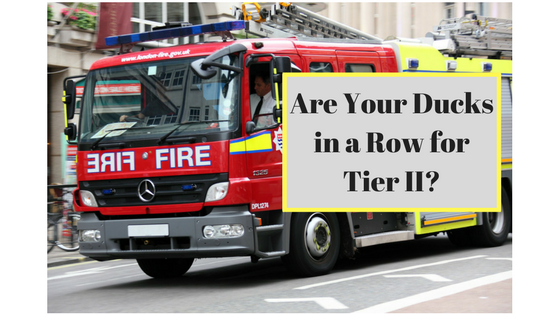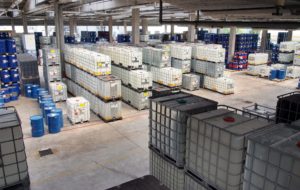Are Your Ducks in a Row for Tier II?
By : Admin -

We are well into the new year; and for many Environmental, Health, and Safety Managers this means being inundated with compliance reporting.
In this post we will take a minute to cover the basics of the Emergency Planning & Community Right-to-Know Act (EPCRA) Hazardous Chemical Inventory Reporting, more commonly called Tier II. Because of this report’s relative simplicity, it can be easily overlooked under the mountain of other compliance reporting due during the 1st quarter of the year.
Why Is Tier II Important?
When facilities report Tier II information, they are providing their state and local emergency planners and responders with valuable information on the hazardous chemicals on-site that may increase the danger associated with crisis situations.
These data are in turn made available by request to the public, so people may get access to information on the hazardous chemicals present in their communities. The federal regulations governing Tier II Reporting can be found in Title 40 Code of Federal Regulations (CFR) §370.
Do You Need to Report?
Tier II Reporting covers those chemicals present on your site during the previous calendar year, which meet both the hazard and reporting threshold criteria listed below:
- The chemical is required to have a safety data sheet (SDS) prepared and/or maintained to comply with the OSHA Hazard Communication Standard found at 29 CFR §1910.1200; and
- The chemical was present in quantities equal to or exceeding:
- Whichever is the lower of 500 pounds or the threshold planning quantity (TPQ) if the chemical is classified as an extremely hazardous substance; or
- 75,000 gallons for gasoline stored in compliant underground storage tanks at retail gas stations; or
- 100,000 gallons for diesel stored in compliant underground storage tanks at retail gas stations; or
- 10,000 pounds for all other hazardous chemicals.
Yet, some chemicals have exemption from Tier II Reporting, including:
- Food and Drug Administration (FDA) regulated food, additives, cosmetics, and drugs;
- Hazardous substances in solid form within manufactured items where exposure would not occur during normal use;
- Chemicals used for personal, family, or household purposes;
- Chemicals existing in the same form and concentration as products intended for public use;
- Substances directly supervised by qualified persons in research laboratories, hospitals, and medical facilities; and
- Chemicals used in routine agriculture activities or as a fertilizer for retail sale.
What Information Do You Have to Submit & by When?
Tier II Reporting entails two types of reporting, SDS and Inventory. The SDS reporting is one-time requirement for hazardous chemicals on your site in quantities above the reporting threshold. However, a new or revised SDS may need to be submitted when:
- New significant information on a hazardous chemical is discovered after the initial SDS submittal;
- A new hazardous chemical becomes subject to reporting; or
- A SDS is requested by a local emergency planning committee (LEPC).
Inventory reporting is an annual requirement for those on-site hazardous chemicals meeting the threshold requirements. Furthermore, as part of the Tier II Inventory Reporting, you will need to provide the following information:
- Site Identification Information (name, address, latitude, longitude, NAICS code, D&B number, Toxic Release Inventory (TRI) facility ID, etc.)
- Site Contact Person (name, title, phone number, and email address)
- Chemical-specific information for each hazardous chemical subject to reporting, including
- Name (as stated on SDS)
- Physical State (solid, liquid, gas)
- Extremely Hazardous Substance Identification
- Physical and Health Hazards
- Maximum Single Daily Amount present at the site
- Average Daily Quantity present at the facility
- Maximum Number of Days present on site
- Storage Container Type
- Storage Conditions (ambient, less than ambient, cryogenic, etc.)
- Description of precise on-site storage location (site plan with coordinates for storage locations and/or description of storage location control measures may be included).
The reporting program is managed predominantly at the state level, but state programs must meet or exceed the federal requirements. Also, some states mandate electronic reporting of hazardous chemical inventories.
Facilities should refer to their applicable state regulations for specific reporting requirements, forms, and procedures. All submittals of the previous calendar year’s information are due on or before March 1st each year.
What about Community Access to My Information?
Anyone can request your facility’s reported Tier II information from the State Emergency Response Commission (SERC) or applicable LEPC. Moreover, regulated sites may be contacted by the SERC or LEPC if they do not have the requested data for your site.
Regulations do allow for names of specific chemicals to be withheld from public release when the names are claimed and substantiated as trade secrets. Additionally, facilities can request withholding from public disclosure the location information for specific chemicals.
How Can You Make Sure You’re Ready for Tier II Reporting?
While Tier II may seem relatively unchallenging when compared to other environmental requirements, each reporter should prepare ahead of time to ensure the submitted report is complete, accurate, and on time. As such, the following tips may help you get your ducks in a row for Tier II:
- Review your hazardous chemical quantities early to determine whether you meet the threshold reporting requirements.
- Pay special attention for any new chemicals present at your site during the previous calendar year.
- Gather all the information necessary to complete your reporting before you attempt to complete any forms.
- Contact your applicable state should you have any questions concerning specific forms, reporting requirements, or submittal procedures.
- Complete & submit your reporting on or before March 1st.
You can also go to the EPA’s dedicated EPRCA webpage to access more information on Tier II Reporting. The webpage provides excellent summary information on the requirements. Additionally, it contains links to the Tier II Reporting Requirements by state.
Other Environmental Compliance Articles of Interest
Environmental Compliance Trends: Discover What’s Hot on the Radar Now
Wrapping Up
We welcome your feedback! If you found this information useful, be sure to like, comment, and/or share below!
Prorsa Consulting assists regulated businesses in assessing, maintaining, and improving their environmental and safety compliance to lower risk. Start working with us by scheduling a complimentary discovery call.
How would you like to have access to additional, exclusive EHS updates & info from Prorsa Consulting? Just signup for the Prorsa Consulting Newsletter below. You’ll get access to our Free Resources area and all the tools, templates, and presentations in the library. Get your free subscription today!


